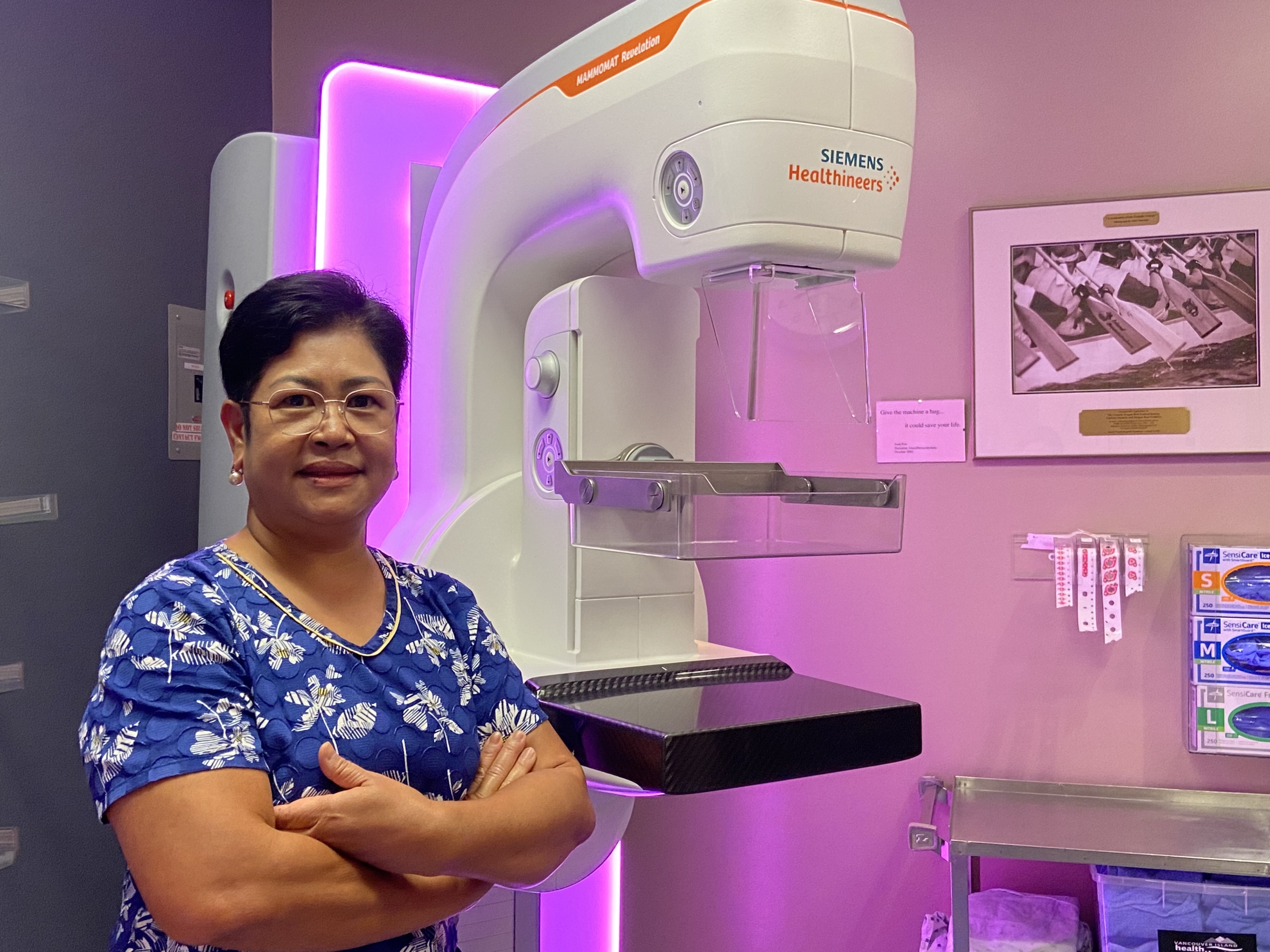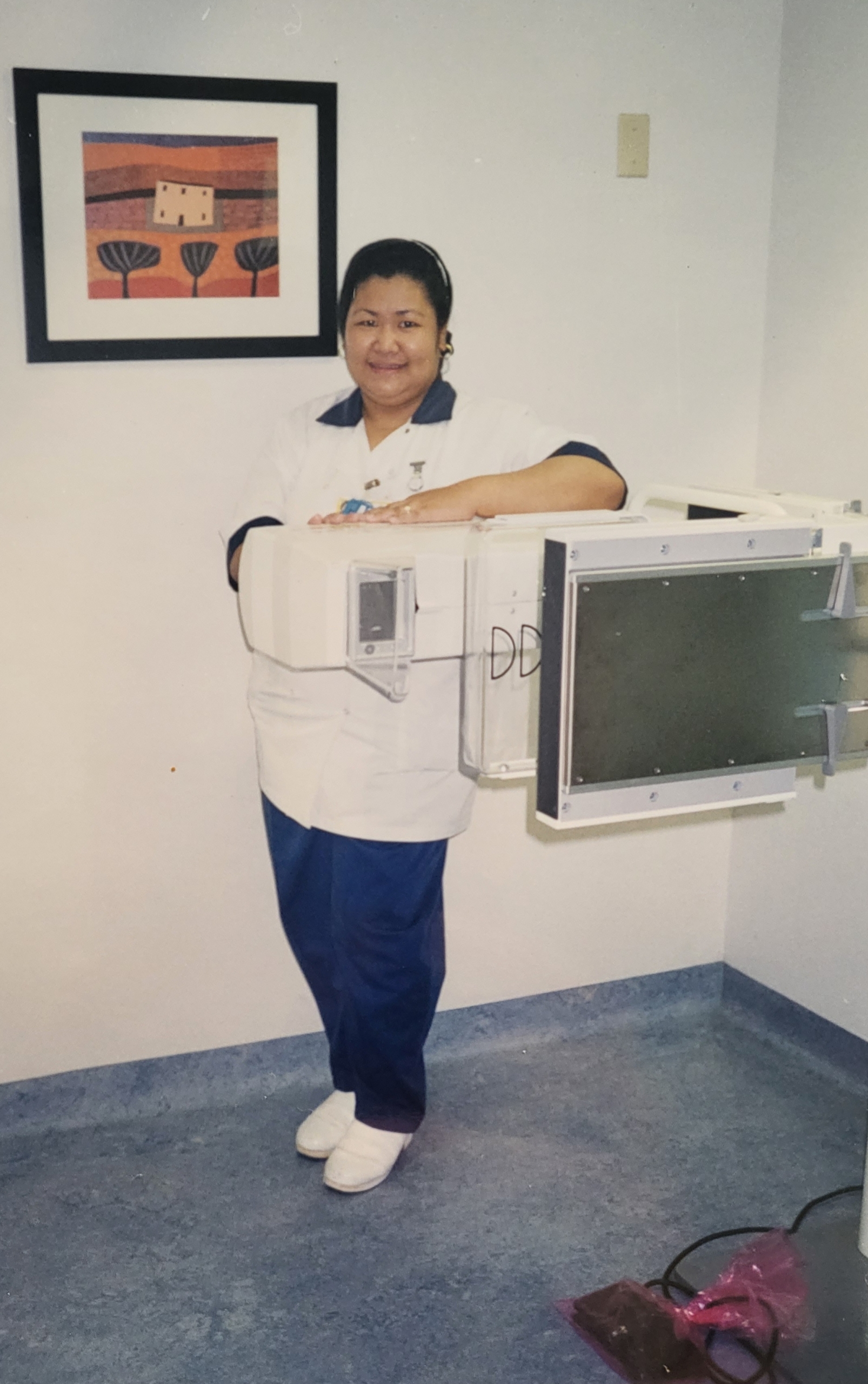
Ruby Manese:
Diagnostic Mammographer, Victoria General Hospital; mother, wife, friend, traveler, board-game enthusiast, human
I am a Diagnostic Mammographer at Victoria General Hospital. Diagnostics is different than the screening mammography program, in that the people I see have clinical concerns, and also include those who have been called back from the screening mammography program. I also see newly diagnosed and post-breast cancer patients.
We work closely with the radiologist, acquiring additional mammographic images, assist with biopsies, and arranging ultrasound and MRI imaging. I can send a patient for an ultrasound if I feel a lump, see dimpling in the skin, or discoloration, even if the mammogram didn’t detect anything. This job requires you to be observant, as well as calm, understanding, and a good listener.
Our patients are often really scared. My mom went through cancer too, so I know how that feels. I always tell my patients, “I’m sorry, I have to pull you more towards the machine, because if I can’t show the doctor what’s in there and I miss something, your life is at stake.” We actually have a sign beside the machine that reads, “Hug the machine. It could save your life.” That’s how I feel every time I perform a mammogram: I could be helping to save a life. That’s the best part of the job for me. I’m part of my patients’ journey. During their biopsy I hold their hands, and remind them not to move. I love my job and I love helping people. I like seeing my regular patients when they come for annual mammograms after breast cancer treatment or surgery. They come to reception and ask if I’m working, and if I don’t see them myself, they’ll just pop by and say “I’m on my way out, but I wanted to say hi to you.” That makes a difference. Makes my day.
“That’s how I feel every time I perform a mammogram: I could be helping to save a life. That’s the best part of the job for me. I’m part of my patients’ journey.”
“Remember film? When I was a student and when I first graduated, we had to dip the film into the solution ourselves to see the images. The technology has just improved and improved. The clarity of the images now save lives. “
I’ve been a Diagnostic Mammographer for 31 years. I was in the Middle East for ten years doing this job and then came to Victoria almost 21 years ago.
I wanted to be an engineer. I am very good at math, numbers are my forte. My co-workers with kids in school will ask me for help so they can help their kids with homework. I grew up in the Philippines and my parents sent me to school, all paid for. They said I could not go to school for math, as it would mean studying away from the province where I lived, which would have been more expensive. My dad said to me, “You have to do the X-ray job, I’m paying for your education, that’s what you’re going to do.” He was influenced by my cousin who works as an X-Ray Technologist. Her name is Arlene and she is the main X-Ray Tech at the Burnside Clinic, here in Victoria. I enrolled, and I ended up really liking it.
When I was a new grad, I went to Saudi Arabia and was trained to do mammography. I also learned lithotripsy, fluoroscopy, angiogram, and CT. When I started doing mammograms, I was like, “Oh, I really like this.” I began training in assisting biopsies and other special procedures in the breast.
When my family moved to Canada, I challenged the certification exam. My husband and I had two small kids, a one and five year old, and I thought, “I can’t go back to school. I need to pass the certification.” I reviewed it on my own and, fortunately, I passed. Then, because I had done so much in my role in the Middle East, when I started at VGH they really didn’t have to train me. That felt so good.
Over the last 30 years I’ve seen tons of advancements in imaging. Tons. Digital Mammography and 3D imaging (tomography) is amazing. Remember film? When I was a student and when I first graduated, we had to dip the film into the solution ourselves to see the images. The technology has just improved and improved. The clarity of the images now save lives. It’s amazing.
Sidney is home. It felt like home the moment we moved here. I know it’s normal for a lot of people to move from one place to another, but not with us. My kids grew up on the Island and they are not talking about moving away. My son, Royce, is a nurse at Six South at Royal Jubilee, and my daughter, Ruth, is in second year social work. My husband, Rex, says our kids are in jobs helping other people because of me.
Our kids still live with us, as do their partners, so there are six adults in our home, plus our two dogs: Tobio and Bok choy. We do a lot as a family. We watch movies, we love Wednesday wings night, and we play games. We found a new game that we’re crazy about called “Left, Right, Centre.” You never know who’s going to win and you just have to roll the dice and it tells you what to do. My husband, who is very competitive, makes it fun. He loves to see me lose. It makes him laugh so hard.
My husband and I love to travel; we work hard and then we play. Since last year, we’ve been to New York, Las Vegas, Alaska, Cancun, and I’m going on a Caribbean cruise in the spring. With travel, it’s always new and so exciting the first time you see something you had only seen before in photos. We just went to Chichen Itza, in Mexico. It’s one of the Seven Wonders of the World, and it’s so beautiful.
I’m grateful to be able to travel, and then return to a home and job I love.
“My son, Royce, is a nurse at Six South at Royal Jubilee, and my daughter, Ruth, is in second year social work. My husband, Rex, says our kids are in jobs helping other people because of me.”
They are humans first, who put other humans first.
More than 8,900 caregivers and staff work around the clock in our Victoria Hospitals
#HumansFirst is dedicated to sharing the stories from behind our hospitals’ frontlines. These stories remind us that those who provide care and keep the lights on in our hospitals also have lives outside of them. They have family and friends, they enjoy hobbies and interests, and they have all lived through their own personal triumphs and heartbreaks. Like all of us, they are human, and they have a story to tell.







